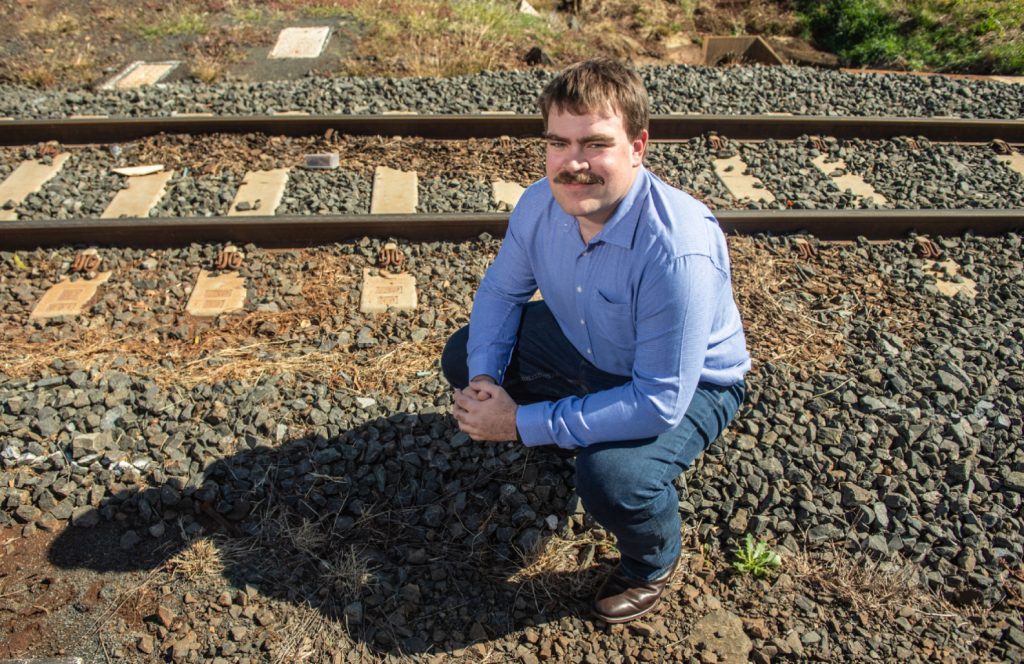Timber railway sleepers may be highly sought-after in garden landscapes, but in railway infrastructure they are less than ideal.
They need to be replaced every 10 to 20 years, which is getting increasingly difficult and expensive due to availability and environmental concerns, not to mention the level of disruption caused every time an upgrade is required.
However the work of a University of Southern Queensland (USQ) graduate may signal the way to improve the sustainability and durability of our railway system.
Thomas Murphy’s honours thesis focused on how emerging railway sleeper technologies could impact track behaviour in Australia and optimal interspersing ratios for different materials.
His work has been recognised by the Institute of Public Works Engineering Australasia, who chose him as the winner of the Futures Challenge last year, and he has also won the Railway Technical Society of Australasia Undergraduate Thesis Award.
Three-phase interspersing study
Thomas says his thesis was split into three main areas. First was to analyse railway sleepers using beam on elastic foundation equations to evaluate current design methodologies and look at the effect of critical parameters such as the length of the sleeper and the spacing between the sleepers. He validated this with a finite element analysis model.
“Then I started looking at analysing sleepers with different materials. Timber was my benchmark, as that’s what’s currently used, and concrete, synthetic composite and recycled plastic; looking at the different forces in those and how much they bend and deflect, using one single railway sleeper,” he said.
“Then my third area looked at a section of railway tracks – 11 railway sleepers – looking at the effect of interspersing with different ratios and then evaluating the load distribution on a section of track.”
Thomas says the understanding of the effects of available sleeper technologies on the rail track behaviour is quite limited.
“There’s a lot of these new materials coming out that could be used for our sleepers. But from my understanding, railway authorities aren’t very keen to trial new sleeper technologies because they want to be sure it will be there for a good 30 years,” Thomas said.
Different ratios for different materials
His research wasn’t so much focused on the composition of the sleeper, but more on the best way new materials could be integrated as timber sleepers wear out.
“I thought it was probably quite important to have recycled plastic sleepers in there — looking at sustainability and seeing if they’re a viable option. All the materials I looked at in terms of interspersing ratio — concrete, synthetic composite and recycled plastic in conjunction with in-service timber sleepers — look like feasible options.
“You just have to be mindful of the interspersing ratios, as in how many you use over a certain number of timber railway sleepers, and I have suggested some dispersion ratios that would be the best to use for particular materials,” he said.
“For instance, for materials with a higher modulus of elasticity value in the sleeper, such as concrete, my results suggested a smaller interspersing ratio such as 1 in 2: concrete, timber, concrete, timber. Whereas for synthetic composite, or recycled plastics, their modulus of elasticity values are a lot lower, closer to timber. So 1 in 4 is probably more ideal for them,” he said.
He says the interspersing ratios will help in the maintenance of our rail infrastructure, and that as his research was done with a fixed ballast conditions about the rocks, further research could be done looking at a different ballast.
The value of real-world-data
The ideal next step for Thomas’s research would be to get in-field results.
“I know that’d be very difficult to do. However, I feel if you could get some real-world data that would really help to validate some of my analytical findings,” he said, adding that there is always a lot of interest whenever he presents his thesis to engineering professionals.
“A lot of them don’t realise there is a lot of research going on in this area. Even as a railway enthusiast, I didn’t realise until I started this thesis that there was a hell of a lot going on in the railway sleeper world.”
In the meantime, Thomas is enjoying his role as the first civil graduate with Energy Queensland. “It’s a bit different to my railway engineering thesis, but there are a lot of exciting opportunities here,” he said.
The new and improved Engineers Australia Excellence Awards are now open for nomination. Learn more about the awards program and how to nominate here.
